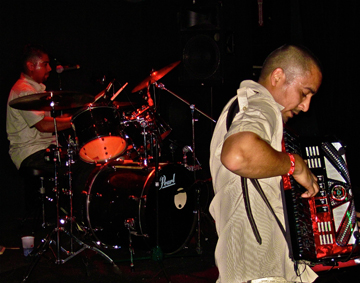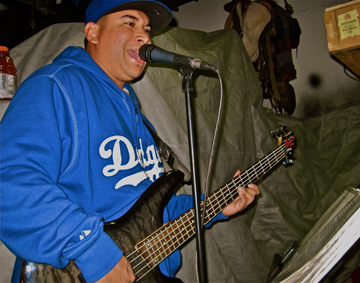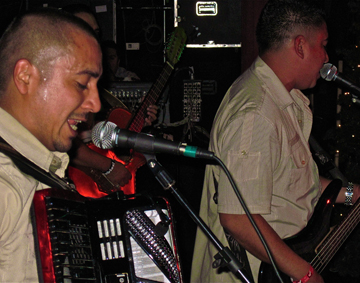 From a back alley in Wilmington, illuminated by the twinkling lights of the nearby oil refinery, the sounds of the Mexican-drug war come alive on a windy Wednesday evening — not through gun shots, police sirens or the wailing of widowed mothers — but through song.
From a back alley in Wilmington, illuminated by the twinkling lights of the nearby oil refinery, the sounds of the Mexican-drug war come alive on a windy Wednesday evening — not through gun shots, police sirens or the wailing of widowed mothers — but through song.
“Loyalty to the bosses, or you’re an enemy,” croons 27-year-old Jesse Castañeda in Spanish into a microphone in his home garage, rehearsing for an upcoming show. Jesse is the lead-singer of the four-piece Wilmington band Komando de la Klika. The song, called “Scarface Reborn,” tells the violent tale of a Mexican drug lord executing his foes.
The Music
Komando de la Klika mostly plays songs known as narcocorridos. The popular Mexican-folk ballads have been around since the creation of the U.S. – Mexico border in the 19th century, but the current form of narcocorridos took shape in the 1970s when lyrics evolved into sensationalistic descriptions of drug traffickers and drug violence.
“We sing a lot about killings and some of the violence that goes on in Mexico … about new drug lords or cartels,” says Castañeda, whose brothers Henry, Juan and friend Gerardo Moya are part of the band. All of them are first-generation Americans born and bred in Wilmington.
The group, whose name Jesse translates as “soldiers for the people,” also plays other styles of northern-Mexican music such as rancheras and cumbias, which have nothing to do with drug violence. The band’s set list is mostly made up of cover songs of well-known Mexican artists.
 Though corridos are still popular south of the border, many Mexican officials are taking steps to stop this glorification of cartel culture. In May, the northwestern Mexican state of Sinaloa, which is home to the most powerful cartel in the country, banned public performances of narcocorridos. The nearby states of Chihuahua and Baja California have also banned radio and television stations from playing the songs. The crackdown has helped turn Los Angeles into the commercial hub of the genre.
Though corridos are still popular south of the border, many Mexican officials are taking steps to stop this glorification of cartel culture. In May, the northwestern Mexican state of Sinaloa, which is home to the most powerful cartel in the country, banned public performances of narcocorridos. The nearby states of Chihuahua and Baja California have also banned radio and television stations from playing the songs. The crackdown has helped turn Los Angeles into the commercial hub of the genre.
Josh Kun, music critic and director of the Popular Music Project at USC’s Norman Lear Center, described the industry’s geographic shift north.
“Really where they have taken off and where the real growth industry is in narcocorridos … is right here in Los Angeles,” said Kun. “The vast majority of the biggest names in narcocorrido … are, if not from Los Angeles and southern California – now based here,” Kun says.
Pasadena-born Gerardo Ortiz is a prominent example of local success in the genre. Ortiz took home six Billboard Mexican Music Awards in October, given based on album sales and radio play. Ortiz, who lives in the U.S., spent part of his youth in Sinaloa.
Even at the top of the charts, Ortiz, like other Mexican artists, is not immune to the violence in Mexico. In March, Ortiz escaped unharmed when armed gunmen attacked his vehicle after one of his concerts in Mazatlan, but his cousin and driver were killed, allegedly at the hands of drug lords unhappy with Ortiz’s songs glorifying their rivals.
Several other popular narcocorrido singers have been gunned down in recent years such as Diego Rivas, who was murdered in Sinaloa on November 14 of this year, and Sergio Vegas, who was killed there in 2010. As a result, southern California has become a safe haven for narcocorrido singers who may find themselves targets for violence down south.
In Los Angeles, narcocorridos can be heard daily on mainstream Spanish-language radio stations such as KBUE 94.3FM, one of the top 10 Spanish-language radio stations in the nation and averages over 30,000 listeners every 15 minutes according to recent Arbitron ratings. Both Kun and Jesse Castañeda point out that the music has a broad fan base in the Mexican and Mexican-American community that crosses boundaries of gender and age. There are live performances throughout the city at venues such as El Rodeo night club in Pico Rivera, El Parral dance club in South Gate and Normandie Casino in Gardena.
The Escalation in Violence
Since Mexican President Felipe Calderón announced his crackdown on the cartels five-years ago, the drug war has only grown more violent. The Mexican government announced this year that it estimates 34,000 drug-related deaths occurred in the country between 2006-2010. Some advocacy groups, such as the peace movement led by poet Javier Sicilia, put the number around 40,000, which doesn’t include the thousands of Mexicans who have simply disappeared without a trace.
Narcocorridos have mirrored their homeland in recent years, with songs growing more graphic in response to the pandemic violence spreading its way across Mexico.
Kun describes the violent evolution of narcocorrido lyrics: “In the 1970s, a narcocorrido singing about decapitation would have been unheard of – now it’s commonplace.”
Jesse agrees and says many artists try to one up each other to see who can sing the most violent song. “Over the past couple years I think they’ve gotten worse, as have the times in Mexico.”
The Gigs
On a Friday night in Gardena, Henry Castañeda pounds out a furious accordion solo as he moves across the stage with sweat pouring down his face. His brother Juan keeps the up-tempo rhythm going throughout their hour-long set. Third-brother Jesse belts out the lyrics of “Scarface Reborn” in the lounge at the Normandie Casino, regaling the crowd with the tale of a vengeful drug lord and his 5.7-caliber pistol.
 Groups of dolled-up females in their 20s and 30s, some with boyfriends and some without, gather around long tables sipping brightly-colored alcoholic drinks. Enticed by the music’s danceable beat, two women make their way to the dance floor, joined later by a couple eager to show off their moves.
Groups of dolled-up females in their 20s and 30s, some with boyfriends and some without, gather around long tables sipping brightly-colored alcoholic drinks. Enticed by the music’s danceable beat, two women make their way to the dance floor, joined later by a couple eager to show off their moves.
Jesse says fans at their shows tend to skew young and female, ranging from 18 to 27 years old. Erandi Merino, a 23-year-old Santa Ana-resident is one of those fans. Like many others in attendance, she showed up to the band’s latest show wearing a short black dress and heels.
Merino says that while she likes the music more for its sound rather than the gruesome stories, she’s not particularly bothered by the words. “If the music is happy, and you’re drinking and you’re with friends … you’re just with it.” She dismisses the notion that narcocorridos are a corruptive influence on children.
“It’s part of life. I grew up with it, so why can’t they? I didn’t grow up to be a violent person, so I don’t think they would either,” Merino says.
Jesse says that while his group doesn’t advocate violence, they have an obligation as performers to play what’s popular amongst their audience.
“We’re not for all the violence. We’re peaceful people, but it’s mostly what the people want to hear,” he says. Henry chimes in. “We just have to go out there and make the money,” he says.
Merino says narcocorrido fans listen to the music for the same emotional reasons as fans of gangster rap. “They feel powerful. They want to be like the people they talk about in the corridos,” she says.
However, Juan points out that they have played gigs where the more modern corridos are frowned upon. “There’s been gigs we’ve gone to where people tell us ‘no corridos.’ They want more cumbias; more of the old-school corridos,” he says.
The Future
Kun believes narcocorrido singers should stop paying lip service to the condemnation of violence and start actively critiquing it. “Every narcocorrido singer I’ve ever interviewed … all say, immediately, that they are opposed to violence … yet none of them have written songs critiquing it,” Kun said.
Perhaps that process will start with Jesse, who says he plans to write songs depicting tamer subject matter. “I have given thought of making songs … drifting away from the cartel stories – that kind of tell stories about stuff we’ve been through … maybe not anti-violence – but just drifting another way,” he says.
Until then, idealism will continue to give way to the stark realities of Mexican life, and the alley behind the Castañeda house, along with night clubs across Los Angeles, will reverberate with tales of war and death.















Speak Your Mind